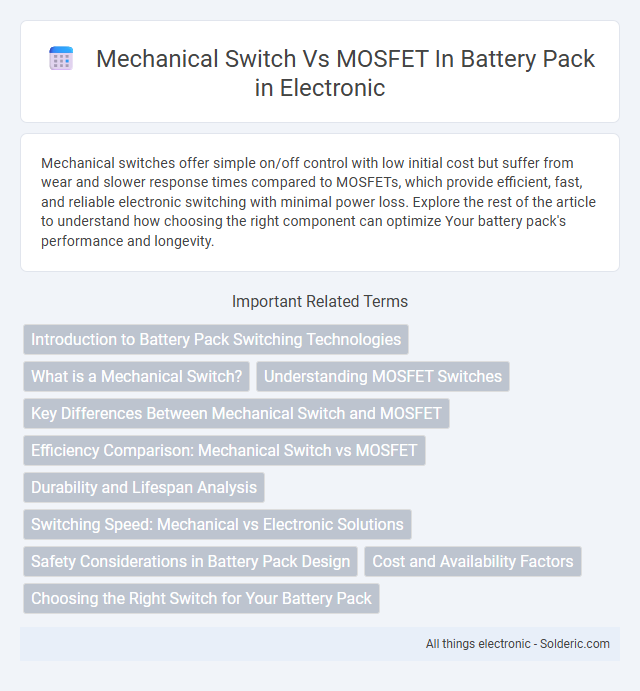Mechanical switches offer simple on/off control with low initial cost but suffer from wear and slower response times compared to MOSFETs, which provide efficient, fast, and reliable electronic switching with minimal power loss. Explore the rest of the article to understand how choosing the right component can optimize Your battery pack's performance and longevity.
Comparison Table
| Feature | Mechanical Switch | MOSFET |
|---|---|---|
| Operation | Manual or relay-driven physical contact | Electronically controlled semiconductor |
| Switching Speed | Slow (milliseconds) | Fast (nanoseconds to microseconds) |
| Durability | Limited cycles due to wear | High cycle life, no mechanical wear |
| Current Handling | Limited by contact rating | High current capability with low resistance |
| Voltage Drop | High contact resistance results in voltage drop | Low R_DS(on) for minimal voltage loss |
| Power Efficiency | Lower due to contact resistance and mechanical losses | Higher efficiency with low conduction losses |
| Size & Weight | Bulkier, heavier components | Compact, lightweight semiconductor |
| Control Complexity | Simple switching, no control circuitry | Requires gate drive and control circuitry |
| Cost | Generally low initial cost | Higher initial cost, offset by efficiency gains |
| Reliability in Battery Pack | Prone to mechanical failure, contact degradation | Robust under electrical and thermal stress |
Introduction to Battery Pack Switching Technologies
Mechanical switches in battery packs provide reliable manual control through physical contact points, ensuring straightforward on/off functionality but are prone to wear and contact degradation over time. MOSFETs (Metal-Oxide-Semiconductor Field-Effect Transistors) offer advanced electronic switching with faster response, lower power consumption, and enhanced durability, making them ideal for automated battery management systems. The choice between mechanical switches and MOSFETs significantly impacts efficiency, longevity, and safety in battery pack applications.
What is a Mechanical Switch?
A mechanical switch in a battery pack is a physical device that opens or closes an electrical circuit by moving contacts manually or through a mechanical action, allowing or interrupting current flow. It commonly uses metal contacts that physically touch to complete the circuit, offering simplicity and straightforward operation with clear on/off states. Mechanical switches provide reliable tactile feedback and isolation but may be prone to wear and contact degradation over time compared to semiconductor alternatives like MOSFETs.
Understanding MOSFET Switches
MOSFET switches offer precise control and high efficiency in battery pack management by rapidly switching current with minimal resistance and heat generation. Unlike mechanical switches that rely on physical contact, MOSFETs use semiconductor technology to handle higher currents and extend battery life. Your battery system benefits from improved durability and faster response times when integrating MOSFET switches.
Key Differences Between Mechanical Switch and MOSFET
Mechanical switches rely on physical contact to open or close circuits, causing wear and slower response times compared to MOSFETs, which use semiconductor technology for faster, more reliable switching. MOSFETs offer higher efficiency by minimizing power loss and heat generation, making them ideal for battery pack management where energy conservation is critical. Your choice between a mechanical switch and a MOSFET impacts device longevity, switching speed, and overall battery performance.
Efficiency Comparison: Mechanical Switch vs MOSFET
Mechanical switches typically exhibit higher resistance and slower switching speeds compared to MOSFETs, resulting in lower efficiency and increased power loss in battery packs. MOSFETs offer near-zero on-resistance and faster switching capabilities, which significantly enhance energy efficiency and extend battery life by minimizing heat dissipation. Optimizing your battery pack with MOSFETs ensures superior performance and energy savings over mechanical switches.
Durability and Lifespan Analysis
Mechanical switches in battery packs typically offer a lifespan of around 100,000 cycles but are prone to wear due to physical contact degradation and contact oxidation. MOSFETs provide superior durability with lifespans exceeding millions of switching cycles, as they operate without mechanical parts and leverage semiconductor properties for switching. The solid-state nature of MOSFETs ensures consistent performance and reduces maintenance, making them ideal for high-reliability and long-term battery management applications.
Switching Speed: Mechanical vs Electronic Solutions
Mechanical switches in battery packs typically exhibit slower switching speeds due to physical contact movement, often measured in milliseconds, which can limit performance in high-frequency applications. MOSFETs provide significantly faster switching speeds, operating in microseconds or nanoseconds, enabling efficient power management and minimal energy loss. Your battery pack benefits from MOSFET integration when rapid switching and precise control are essential for optimizing efficiency and extending battery life.
Safety Considerations in Battery Pack Design
Mechanical switches in battery pack design offer straightforward physical isolation, reducing the risk of short circuits and providing clear disconnection points for safety. MOSFETs enhance protection by enabling rapid, precise electronic control over current flow, allowing for features like overcurrent and thermal shutdown to prevent damage. Your battery pack's safety depends on selecting the appropriate switch type that balances reliability, response speed, and fault tolerance for optimal performance.
Cost and Availability Factors
Mechanical switches generally offer lower initial costs and greater availability due to their simple design and widespread manufacturing, making them a cost-effective choice for basic battery pack applications. MOSFETs typically have higher upfront costs because of their semiconductor complexity but provide benefits in efficiency and longevity, potentially lowering long-term expenses in advanced battery systems. The decision between mechanical switches and MOSFETs often hinges on budget constraints, production volume, and required performance characteristics.
Choosing the Right Switch for Your Battery Pack
Selecting the right switch for your battery pack depends on the specific application requirements such as current load, switching speed, and efficiency. Mechanical switches offer simple, reliable on/off control with low cost but may suffer from wear and slower response times. MOSFETs provide high-speed switching, greater efficiency, and better thermal management, making them ideal for modern battery management systems where precise control and durability are essential.
Mechanical switch vs MOSFET in battery pack Infographic

 solderic.com
solderic.com